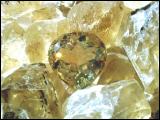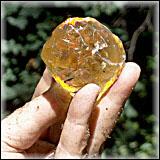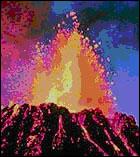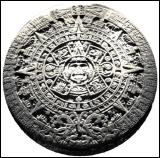Information Englisch
Infos about golden sunstones - myths & legends
The Stone of the golden sun
It was the Time of the Fifth Sun.
The great Emperor, Cuauhtémoc, looked out over the island city of Tenochtitlan and its population of more than a quarter of a million people. Here before him stood the capital of an Aztec Empire that spanned thousands of square miles and was the unquestioned pinnacle of American civilization. So peaceful…so reassuring; and yet…all of this was in grave and imminent danger.

For the great volcano near the city, Popocatepetl, had erupted, and with mighty blasts Xiutecuhtli, the God of Fire, had filled the sky with black clouds of soot and ash. Day had turned to night. The Sun God, Tonatiuh, had been made captive of “the jaguar heart of the mountain”, the powerful Lord of the Night, Tepeyolothli. Crops were starting to wither and die. The rivers were thickened with ash, and the fish and animals had fled. The people were in a state of panic.
A delegation of nobles had begged the Emperor for help. The situation was desperate. How could the Sun God be released from captivity? Surely the Emperor would have the wisdom to find a solution! Cuauhtémoc desperately searched his memory for details of a long-forgotten story from his childhood. Slowly a glimmer of hope crept into the corner of his consciousness. Yes….perhaps…there might be a way, but it lay buried in the ancient myths and legends of Aztec culture. The only hope for his people was the chance that one of these myths might actually have a basis in truth. Was such a thing possible?

There was little time to waste - the Emperor had no choice. He immediately assembled a small band of his best runners and trackers and gave them details of a story passed down through generations, a story so fantastic that Cuauhtémoc scarcely believed it himself.
The ancient myth suggested that in the days of pre-history, long before men, a battle had been waged between Tonatiuh, the Sun God, and Tlaltecuhtli, the God of Earth. The Earth God won this battle. To memorialize the triumph of his victory he created a special SUN-STONE in which he imprisoned his defeated rival. Tlaltecuhtli then broke the stone into millions of pieces and scattered them into boiling lava, which eventually cooled into dense, black rock that would forever keep Tonatiuh within the earth…and within his grasp.
This plan might have worked, except for the unexpected intervention of Tialoc and Quetzalcoatl, the Gods of Water and Wind. Over millennia of uncounted time, these elemental forces struggled against the dense black lava rock that had encased the bits and pieces of Tonatiuh’s prison. Eventually the rock was worn away, unlocking the golden fragments and allowing them to accumulate on the surface of the ground. When enough of them had been released, Quetzalcoatl blew them high into the sky, restoring Tonatiuh to his rightful place in the heavens. According to the legend, the Gods of wind and water continued to tear at the rock and expose more of the golden fragments, to make sure that someday ALL of Tonatiuh would be freed. The ancient Aztec priests had given a name to the magical rock that imprisoned the Sun God. They had called it the Stone of the Golden Sun.
Cuauhtémoc prayed that his idea would work. The location of the Stone of the Golden Sun was far to the north in a remote volcanic area. If his runners could track it down and bring back some of the ancient fragments of Tonatiuh, then perhaps returning these to the lavas of Popocatepetl would appease the Fire God Xiutecuhtli and save his people!
After weeks of searching, the runners finally discovered a place that seemed to fit the descriptions of the ancient legends. In a remote valley lay a tiny area in which bright, golden yellow stones literally covered the ground. These stones were amazing – and unique - transparent and hard, unlike anything ever seen before. The Emperor’s team scooped up as much of the stones as they could carry and rushed back to Tenochtitlan.

The situation at home had become truly desperate. There was no time to waste! The Emperor’s astronomer-priests carried the pieces of golden SUN-STONE to a spot where the full fury of the volcano could not only be seen, but also be felt! And with loud cries and incantations they hurled the stones out into the hot plumes of lava. The stones quickly disappeared into the incandescent cauldron. Within minutes, the fiery eruption ceased. By morning the tower of ash and dust had begun to settle. The God of the mountain had been appeased and the city was saved from destruction.

In 1790 an amazing carved stone was excavated in the center of Mexico City, an artifact now believed to be a symbolic representation of the Aztec view of space-time. This object, an immense disk of dark, basaltic rock a meter thick, 1.6 meters across and weighing 24 metric tonnes, has come to be known as the Sun-Stone. All the existing studies of Aztec culture, religion and myth emphasize the unique importance of the sun. The entire religious and military focus of their civilization revolved around sacrifice to the Sun God and a fanatical need to prevent darkness from overtaking the land. There is no modern counterpart to the religion that so dominated Aztec culture. However, the sun and its symbols remain vitally important to native peoples throughout the Americas.

The Stone of the golden sun
There is no way to prove or disprove the legend of Tonatiuh and Xiutecuhtli. We do know, however, that Mexico is a volcanic country and eruptions have plagued its occupants for centuries. We do know that there is a tiny area in remote northern Mexico where bright golden yellow crystals have weathered out of dark basaltic rock and lie scattered on the ground. We do know that while this surface material has been exposed for a long time and is not completely flawless, the golden yellow crystals still trapped within the basalt are transparent, unusually hard, and generally unlike anything found anywhere else on earth.
This deposit is known as La Mina de La Piedra del Sol Dorado, which means “The Mine of the Stone of the Golden Sun”.
Sunstone - Markets and Overview
© Joel E. Arem, PhD, FGA rev. 7-02
The market for sunstone has been growing for nearly 50 years. Tiffany & Co. at one time had even considered using the gem in a major marketing program! The material is mined chiefly in the state of Oregon; it is the Oregon State Gemstone, and is the largest contributor to the state’s gemstone production revenues. However the mining is primarily in the hands of small operations, ranging from weekend diggers to 5 to 6-person crews with limited machinery and very small operating budgets.
Oregon sunstone occurs in lava flows and, because of the presence of copper in the rock, comes out in a wide variety of colors: very pale yellowish-brown, green, blue-green, blue, orange, and red. Copper inclusions also create a metallic sheen within some of the material. This effect is known as "Schiller" and makes the gems more or less opaque, but also creates a unique and attractive appearance, sometimes with a pinkish tone. These gems are suitable mainly for cabochons. The color in Oregon sunstone is thus extremely variable, and usually there are several colors present in an individual crystal. The same crystal would therefore produce a huge variety of apparent colors if cut in different orientations. Moreover the attractive coloration generally is concentrated in small areas within a near-colorless matrix, limiting severely the available options for cutting an attractive gemstone and also drastically reducing the potential the yield of cut gems from the rough.
The huge variation in color and optical effects, pronounced zoning, abundant flaws and inclusions, general small size of rough and variability in selection of orientation all results in a significant market factor: it is extremely difficult to produce large numbers of cut gems that look exactly the same. This is a major disadvantage in a marketplace that demands uniformity in order to support the mass-production and distribution of jewelry. In order to produce a large number of gems of (visually) identical size and appearance it is therefore necessary to cut a truly immense number of stones from which to select and match. The cost of cutting such a large number of gems has heretofore far exceeded the cash resources of any of the existing sunstone mining operations.
The result of this limitation is that, despite abundant market awareness and publicity and a growing base of demand, there has never been large-scale availability of sunstone. As a result there has never been sufficient interest among major gem and jewelry distributors to publicize and promote sunstone and bring the material into prominence in the world market. Sunstone is a feldspar, and all feldspars have a hardness of approx. 6 on the Mohs scale. By comparison, tanzanite is about 6.5, opal is 5.5, garnets and zircon are 6+ but very brittle, and most gems used in rings are 7+. Sunstone is very durable and wears very well in jewelry, actually probably better than opal, tanzanite, garnet and zircon. The major sunstone producers have now created a "Co-op" for mutual assistance in mining, cutting and promotion. Their commitment is to try to bring sunstone fully onto the world gemstone "stage" through the promotion of material from many localities. However, the basic problems of poor infrastructure, small deposits, limited capital for both mining and cutting, and extreme variation in appearance among cut gems, all affect Oregon sunstone production and marketing.
There is, however, a unique sunstone deposit that is in North America but some considerable distance from the established Oregon claims. The lava flow in this deposit is a very "pure" basalt and contains no measurable copper; the only significant metallic component is iron, which is the 4th most abundant element in the earth’s crust and present in virtually all igneous rocks. The feldspar in this flow apparently crystallized at depth for a very long time before the rock was extruded to the earth’s surface, and grew with no chemical contamination from impurities that would impede crystal growth and perfection. As a result, the feldspar crystals are a bright, pure golden yellow color (due to ferric iron) with no apparent color variation at all.
The crystals also occur in sizes up to as much as 150 grams (typical Oregon size is 5-15 grams) and nearly all the crystals are glassy and transparent and almost completely devoid of imperfections. There are no optical effects (Schiller) to reduce transparency, and no color zoning whatever. The crystals can therefore be cut without regard to orientation and extremely high yields are routinely achieved (30-50%, versus the 5-10% from Oregon rough). The average sized crystals in this flow would yield cut gems between 3 and 10 carats (the Oregon average would be 1-3 carats). The largest cut gem recorded from Oregon rough (a stone labeled "the Promise" that also displays prominent Schiller under the table) is about 54 carats. By contrast, this deposit has already produced a nearly-flawless cut stone of 258 carats (the world’s largest plagioclase feldspar gem, by a factor of nearly 5X). Flawless cut gems as large as 30-40 carats can be produced on a (somewhat) routine basis). The deposit is extremely large and extremely rich in cuttable feldspar. This material has been given the trade-name GOLDEN SUNSTONE. Another trademarked name, ROYAL SUNSTONE, refers to golden sunstone cut gems larger than 20 carats.
The unique combination of factors indicated above allows for production of cut sunstone with the following parameters:
***unlimited quantity of cut gems possible to meet any conceivable market demand;
***range of sizes from under 1 carat to 100+ carats, all flawless or eye-clean;
***totally uniform color in all sizes and shapes of equal size up to about 25 carats (the large stones appear a bit darker in shade only as a result of greater light absorption due to their greater thickness);
***all gems are essentially flawless and glassy;
The purity of the crystals and their slow, unimpeded growth deep within the earth has allowed these feldspars to attain an internal crystalline perfection unmatched by plagioclase feldspar from any other known locality; with a hardness close to 7 on the Mohs scale. This hardness and structural compactness allows the material to achieve an unusually high degree of polish, comparable to gemstones of hardness 8 and above; however, being feldspar, this material still retains the basic optical properties of the feldspar group, i.e., low refractive index and birefringence. The totally unique combination of low RI and birefringence, combined with extremely high facet surface reflectivity produces a new and previously un-described optical effect that I have termed pseudodispersion.
Dispersion is the phenomenon seen in a glass prism and is caused by the bending of light rays of different spectral colors at different angular amounts within a gemstone (best seen in diamond). Dispersion is a measurable quantity and different gems display it to different degrees. The dispersion in cut feldspar is among the lowest of all gemstones.
The amazing thing about golden sunstone, however, is the extremely high polish attainable because of its unusually high degree of hardness. This polish makes such gems remarkably bright. But it ALSO allows the gems to return to the observer's eye colors introduced into the stones as a result of reflection from surrounding objects and light sources. These colors appear to be emanating from within the gemstone itself. The result is a "color play" remarkably similar to the true dispersion so familiar to us in diamond.
Golden sunstone therefore resembles fancy yellow diamond, both in terms of brilliancy and dispersion!

(C) 2006 - Alle Rechte vorbehalten